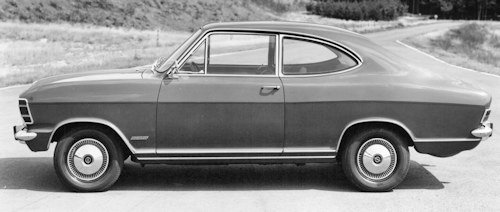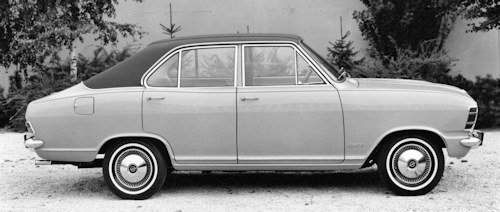Opel Olympia A
 |
|
|
Production period: |
1967 to 1970 |
|
Class: |
Motor Car |
|
Body versions: |
Sedan, coupe |
|
Engines: |
Gasoline 1.1-1.9 litres (44-66 kW) |
|
Length: |
4182 mm |
|
Width: |
1573 mm |
|
Height: |
1354-1400 mm |
|
Wheelbase: |
2416 mm |
|
Curb weight: |
770-880 kg |
The Opel Olympia A was a car which Opel produced between summer 1967 and mid-1970.
History
An Opel Olympia already existed from 1935 to 1953 In 1936, in celebration of the Berlin Olympic Games, Opel launched a model called The "Olympia'". For those days it was an outstanding car, advanced both in technique and style and so much so that its production lasted into the years immediately after the war. Within the Opel range, the Olympia A came in August 1967 as a more luxurious addition to the market.
There were three body versions: two and four-door hatchbacks and the coupe. These models were based on the respective LS models of the Kadett B .Aesthetically speaking, the most striking element is the sawn-off tail, the "fastback" of American origin. In order to diminish the volumes and to give the car a livelier look, the roof sweeps down at the back with a smooth flat line which incorporates the rear window.
Thus in style it is like a G.T. model though losing nothing of the roominess of a saloon.

The car was to fill the gap to the larger record until the appearance of the Ascona A the Opel Olympia A was more powerful engines and better equipped Kadett B There is good all-round vision, too and plenty of light due to the large window area. Particular care and attention has been given to theinterior finishings. If it is true that the Kadett can still be called a run-about, the Olympia immediately claims to a place in a higher class. . With chrome grille with additional trim as well as a more elaborate interior to that of the cadet models. In particular, the vinyl roof, available at extra cost, proved like many others years later became a moisture trap and thus a rust trap under this. Other options alternator and sunshine roof.

The Olympia was also sold in the United States. The safety factor, has been faced and studied with the rigour .The seventeen points listed in the Federal regulations in America at the time on the question of safety standards have all been faithfully accepted by the designers of the Olympia. It should be noted in fact that the central portion of the bodywork is rigid and reinforced while the front and back portions are collapsible under stress so that they would absorb much of the shock of a head-on crash or pile-up. The steering column is a made of reticulated metal which telescopes under a violent blow, thus eliminating the danger of the steering column piercing the driver's chest in an accident. All protuberances have disappeared from the interior, handles are recessed and the roof and facia are well padded, The doors have an aeronautical-type lock. The new ventilation system allows complete air change even with windows closed.

In July 1970, the production of the Olympics ended A. The model was not a particular sales success with 80,697 built copies since differed too little from the favourable Opel Kadett B.The successor was the Opel Ascona A from November 1970 with newly developed and independent body.
The following engines were available:The most economical engine, the 67.12 cu in, 1,100 cu cm or the more powerful 103.77 cu in, 1,700 cu cm or even the 115.94 cu in, 1,900 cu cm.
1.1 l SR, OHV engine with 44 kW (60 hp) and dual gas turbine
ENGINE CAPACITY 65.78 cu in, 1,078 cu cm
FUEL CONSUMPTION 35.7 m/imp gal, 29.8 m/US gal, 7.9 1 x 100 km
MAX SPEED 87 mph, 140 km/h
max power (DIN): 60 hp at 5,200 rpm
max torque (DIN): 62 1b ft, 8.5 kg m at 3,800-5,000 rpm
max engine rpm: 6,000
max speeds: 28 mph, 45 km/h in 1st gear; 49.1 mph, 79 km/h in 2nd gear; 75.8 mph, 122 km/h in 3rd gear; 87 mph, 140 km/h in 4th gear
power-weight ratio: 29.1 lb/hp, 13.2 kg/hp
speed in direct drive at 1,000 rpm: 18.1 mph, 29.2 km/h.
1.7 l S, CIH engine with 55 kW (75 hp)
max power (DIN) 75 hp at 5,200 rpm
max torque (DIN) 94 1b ft. 13 kg m at 2,500-2,900 rpm
max engine rpm 5,600
max speed 95 mph, 153 km/h
fuel consumption 30 m/imp gal, 25 m/US gal, 9.4 1 x 100 km
1.9 l S, CIH engine with 66 kW (90 hp, coupe only)
In particular, the 1.9 l engine allowed in well-retracted copies amazing performance with an acceleration from 0 to 100 km / h in about 10.9 seconds and a top speed of about 170 km / h. Thus, the Opel Olympia was one of the most agile compact vehicles in its class.
Technical
-
Opel Olympia A Technical details and specifications (1967-1970)
ENGINE 1100cc
front, 4 stroke
cylinders: 4, in line
bore and stroke: 2.95 x 2.40 in, 75 x 61 mm
engine capacity: 65.78 cu in, 1,078 cu cm
compression ratio: 9.2
specific power: 55.7 hp/l
cylinder block: cast iron
cylinder head: cast iron
crankshaft bearings: 3
valves: 2 per cylinder, overhead, push-rods and rockers
camshafts: 1, side
lubrication: gear pump, full flow filter
lubricating system capacity: 4.75 imp pt, 5.71 US pt, 2.7 1
carburation: 1 Solex 35 PDSl-2 downdraught carburettor
fuel feed: mechanical pump
cooling system: liquid, sealed circuit1.7-litre S engine
capacity 103.61 cu in, 1,698 cu cm
4 cylinders in line
bore and stroke 3.46 x 2.75 in, 88 x 69.8 mm
9.5 compression ratio
44.2 hp/l specific power
5 crankshaft bearings
1 overhead camshaft
Solex 35 PDSlT-6 downdraught carburettor
4-speed mechanical gearbox (1 3.428, Il 2.156, Ill 1.366, IV 1, rev 3.317)
3.670 axle ratio
power-weight ratio 25.8 lb/hp, 11.7 kg/hp
TRANSMISSION
driving wheels: rear
clutch: single dry plate (diaphragm)
gearbox: mechanical
gears: 4 + reverse; synchromesh gears: I, l, III, IV
gearbox ratios: 1 3.867, II 2.215, III 1.432, IV 1, rev 3.900
final drive: hypoid bevel
axle ratio: 3.890.CHASSIS integral
front suspension: independent, wishbones, lower transverse semi-elliptic leafspring, telescopic dampers
rear suspension: rigid axle, trailing radius arms, transverse linkage bar, coil springs, anti-roll bar, telescopic dampers.STEERING
rack-and-pinion
turns of steering wheel lock to lock: 2.80.
turning circle (between walls): 34.8 ft, 10.6 mBRAKES
front disc, rear drum.ELECTRICAL EQUIPMENT
voltage: 12 V
battery: 1.1L 38 Ah battery, 1.7L 44 Ah battery,
generator type: dynamo, 300 W
ignition distributor: BoschDIMENSIONS AND WEIGHT 4-door Olympia Limousine
wheel base: 95.12 in, 2,416 mm
front track: 49.21 in, 1,250 mm
rear track: 50.16 in, 1,274 mm
overall length: 164.64 in, 4,182 mm
overall width: 63.54 in, 1,614 mm
overall height: 55.12 in, 1,400 mm
ground clearance: 4.72 in, 120 mm
dry weight: 1,742 1b, 790 kgDIMENSIONS AND WEIGHT Olympia Coupé
wheel base: 95.12 in, 2,416 mm
front track: 49.21 in, 1,250 mm
rear track: 50.16 in, 1,274 mm
overall length: 164.64 in, 4,182 mm
overall width: 61.93 in, 1,573 mm
overall height: 55.31 in, 1,405 mm
ground clearance: 4.72 in, 120 mm
dry weight: 1,698 1b, 770 kg© Motor car History
Opel Olympics:
1100 SR
1700s
1900s
engine
4-cylinder in-line engine (four-stroke)
capacity
1078 cc
1698 cc
1879 cc
Bore × stroke
75 × 61 mm
88 × 69.8 mm
93 × 69.8 mm
Power
(hp)
at 1 / min44 kW
(60 hp)
520055 kW
(75 hp)
520066 kW
(90 hp)
5100Max. Torque
at 1 / min85 Nm
3800-5000130 Nm
2800-2900149 Nm
2500-3100compression
9.2: 1
9.5: 1
9.5: 1
mixture preparation
Two downdrafts
carburettors Solex 35 PDSIA downdraft
carburettor Solex 35 PDSIA Registrar
downdraft carburettor
Solex 32/32 DIDTAvalve control
Hanging valves (OHV), side camshaft with single roller chain drive
Hanging valves (CIH), overhead camshaft driven by duplex roller chain
cooling
water cooling
transmission
4-speed gearbox, stick shift (surcharge from the end of 1968: Opel three-speed automatic)
Front
Independent suspension on unequal length, double wishbones, transverse leaf spring (wide gap half spring), telescopic shock absorbers
rear axle
Central joint axis (rigid axle), coil springs, telescopic shock absorbers
brakes
Hydraulic two-circuit four-wheel brake with brake assist
front discs Ø 238 mm, rear drums Ø 200 mm
(at 1700 S / 1900 S rear Ø 230 mm)construction
Self-supporting all-steel body, tank capacity: approx. 40 litres
Gauge front / rear
1250/1274 mm
top speed
140 km / h
153 km / h
168 km / h
0-100 km / h
17 s
14 s
11 s
Consumption (litres / 100 kilometres)
7.9-10.5 s
9.4-11.5 S
9.6-12.0 S
Service
-
Opel Olympia A Technical Service instructions (1967-1970)
fuel: 98 oct petrol
engine oil: 4.40 imp pt, 5.28 US pt, 2.5 1, SAE 20W-30, change every 3,100 miles, 5,000 km
engine oil capacity 1.7L 5.81 imp pt, 6.98 US Pt
gearbox oil: 12.32 imp pt. 14.80 US pt, 0.7 1, SAE 80
final drive oil: 10.56 imp pt, 12.68 US pt, 0.6 1, SAE 90
tappet clearances 1.9L inlet 0.012 in, 0.30 mm, exhaust 0.012 in, 0.30 mm
valve timing 1.9L 44° 86° 84° 46°
cooling system capacity 1.1L: 8.45 imp pt, 10.15 US pt
cooling system capacity 1.7L 12.14 imp pt. 14.59 US pt
greasing: none.
width of rims: 4.5"
tyres: 155 x 13
fuel tank capacity: 8.8 imp gal, 10.6 US gal, 40 1.
carrying capacity: 882 1b, 400 kg© Motor car History
